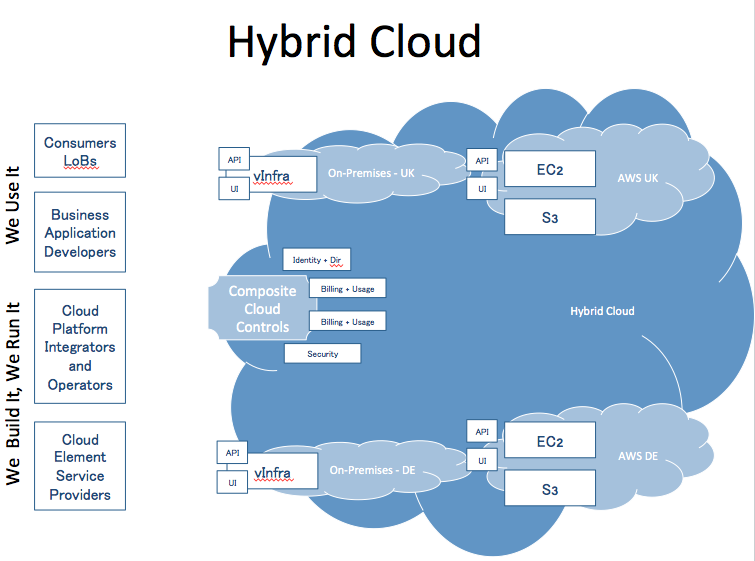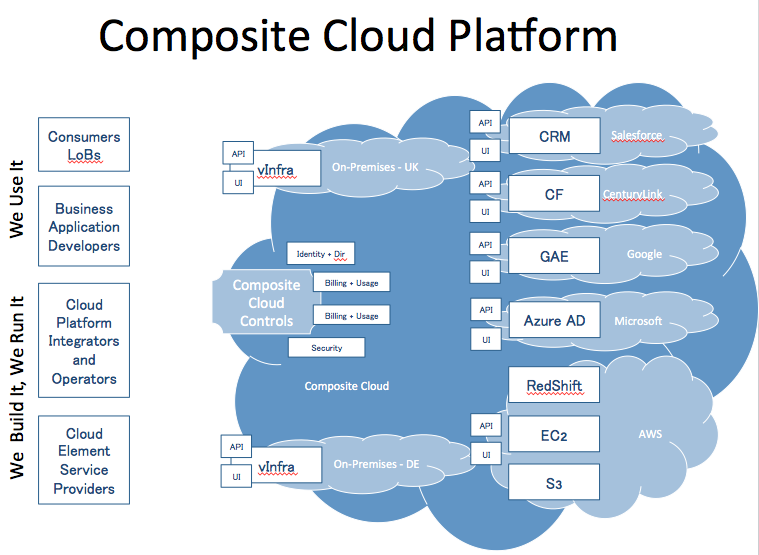Premise
Hybrid cloud is being touted as the best solution for enterprises today but it is under attack. Complex enterprises have complex needs which means they are unlikely to get everything they need from one hybrid cloud. Investing in a single hybrid cloud to glue one private and one public cloud together is not the ultimate answer, as recognised by many referring to hybrid cloud as “a journey”. However, the danger is that if you design for a dual-element hybrid cloud then you will not equip yourself for the extensibility required to snap in/out new/old cloud elements over time, and you will still be down a dead end.
Content
- Problem Statement: Industry innovation changes the game mid-play
- The Eight Tortures of Hybrid Cloud
- Introducing the Composite Cloud
- Final Thoughts
1. Problem Statement: Industry innovation changes the game, mid-play
Enterprise IT continues to be stretched thin by its need to deal with many-year-old legacy systems and at the same time embrace innovation, which is running at an exponential pace. Just look at the amount of new services released by cloud service providers, that are available to all including enterprise IT consumers.
This creates a natural tension in all enterprises when innovation can be de-focused in favour of “keeping the lights on” or when new methods or technologies are not adopted because there is an enterprise desire for “standards” which translates into a “lowest common denominator” approach to IT.
As it relates to cloud, public cloud has evolved beyond “rent a VM” from 2006 to now offering advanced services such as managed databases, content delivery networks and even video encoding/decoding all on a consumption basis. The phrase “undifferentiated heavy lifting” has now moved beyond racking and stacking and low-level infrastructure to these higher order systems.
This has caught private clouds somewhat with their trousers down because they are still mostly at the “rent some infrastructure” stage. Even at this low-level, they lack many other public cloud features, such as types of instances, scalability and availability. To bridge this gap, hybrid clouds emerged to link the on-premises private cloud with the public cloud so that you are promised “the best of both worlds”.
However, to link two clouds together effectively they need to share more than a catalogue or a network connection: to function as a single hybrid cloud they need a hybrid identity system, a hybrid network, a hybrid front end for the hybrid cloud consumers, a hybrid operations panel for the hybrid cloud operators, and more.
This has stretched and tortured the hybrid cloud definition out of shape, and it gets worse when enterprises want to add a third cloud element and swap out existing cloud elements.
2. The Eight Tortures of Hybrid Cloud
A hybrid cloud is accepted today as being constrained as two cloud elements with an infrastructure focus, although it is recognised that additional services are preferred, like Identity, and other services are available, like Managed Database, these stretch the hybrid cloud definition. A simple diagram could look like this, with some example groups of enterprise actors on the left, and the cloud services and providers on the right. In the middle is how the hybrid cloud is glued and presented.

There are eight problems with hybrid cloud today which will twist hybrid clouds to into a tortured cloud that is neither private, public, nor hybrid:
|
Broken Definition |
There is no agreement in the industry on the definition, other than the very abstract NIST definition of linking private and public together. Check the industry leader reference architectures and they are all different. |
|
You Can’t Buy One |
There is no is no single SKU product for a hybrid cloud, from any vendor, though some offer more bits than others. |
|
Multi Clouds over Dual Clouds |
Whilst all enterprises like to simplify the list of partners they work with, it is definitely the case that they will always want the ability to change partners in certain circumstances and it is also the case that they need services that one partner cannot provide on their own, therefore they need to access multiple cloud service providers. |
|
More than IaaS |
From the early days of cloud, IaaS was the focus but far from every cloud service provider being uniform and commodity in a race to zero, they are investing in innovation and differentiation which is leading to many more cloud services available to customers to build their business on, such as content delivery networks and data warehousing. |
|
Bottom Up |
Hybrid cloud is often a bottom-up cloud, effectively connecting “leaf node clouds at the infrastructure level” with little reference to the upper service and management systems, which will most likely be broken by such a complex lower layer. Infrastructure-comfortable cloud leaders will risk the investment in infrastructure-focused clouds and not business/application focused. |
|
Infrastructure becomes the black box |
Whilst there is much use of marketing terms as “application centric” and “software defined”, these are often used by infrastructure companies to appear application and software friendly whilst still having their centre of gravity in the infrastructure, not the applications. This is different compared to the approach of projects like Mesosphere that allows applications to program the infrastructure resources according to their needs, without much knowledge of the underlying infrastructure. Instead of the app-in-a-VM being the black box, roles are reversed. |
|
Hybrid Cloud is an element not a platform |
The emergence of platform plays have had a significant and beneficial business impact, but hybrid clouds don’t exhibit platform features. You may be able to program parts of a hybrid cloud in some fashion (though API inconsistency across hybrid clouds is a clear problem) but a hybrid cloud by itself doesn’t do anything, it’s just a low layer. A difference would be adding a platform layer on top of a hybrid cloud (but isn’t that more than a hybrid cloud now? Hybrid is still a lower layer). |
|
Hybrid Cloud risk lock-in |
A hybrid cloud is designed and implemented to connect two clouds together, usually at the infrastructure layer. So adding a third cloud or non-infrastructure service to something not designed nor built for it is going to be “interesting”. |
More fuel on the fire is being added as we are seeing extra tension come into the industry from the application, platform and consumption focused teams. Platform players such as AppScale, Apprenda, Pivotal, Red Hat and the others focus on the application programming the infrastructure not the other way around, as seen by this recent comment: “The thing about containers is they are all about what’s inside them”.
3. Introducing the Composite Cloud
The pragmatic and common sense approach for enterprises to cloud is to manoeuvre themselves into a position where they have the capabilities to snap in/out cloud services to build their own composite cloud, rather than creating a hybrid cloud that isn’t designed for extension and inherits the good and bad traits of the private and public cloud elements.

In effect, the staff that run the Composite Cloud should think of it as an adaptable and extensible architecture that has consistent elements such as identity, but variable elements such as resources like a private cloud. Google already did this with the datacenter, and enterprises could elevate their thinking above the elements such as private, public and hybrid to an enterprise-wide cloud composed of those elements.
One of the benefits AWS talk to of when they add a service “it is available to everyone” and as that service is improved “everyone benefits from the improvements, immediately”. In effect, if an enterprise emulated the attitude of innovative cloud service providers they would change the attitude of the business to IT.
The one danger to the Composite Cloud Computer approach is in the people. IT have traditionally been the ones that decide how IT is consumed, but this is changing to a consumption focus.
4. Final Thoughts
This is not an easy ask, but neither are the alternatives. A composite cloud is an approach to not get locked in to a hybrid cloud that restricts the add/remove of cloud services over time. That’s not to say hybrid clouds are a poor choice: far from it. The change in the industry as adding new services that weren’t envisaged when hybrid cloud was thought of a few years ago.
To action a composite cloud in an enterprise is to recognise that the complexity of the enterprise isn’t going to go away and indeed will mutate over time and that the only way to give the business the technology boost it needs is to both get out of its way and apply controls in parallel.
This will require a new attitude of enterprise IT staff to become service integrators and own the control layer that defines the composite cloud. This will require new skills in APIs, coding, cloud elements and more. This isn’t a huge multi-year project, it is a constant journey where changes are added regularly. It is ok for some parts of enterprise IT to not make it into the cloud, but with use of cloud proxies and APIs those old legacy systems could get a new lease of life.
Action Needed: Avoid the potential dead-end and difficult-to-pivot route of infrastructure-led hybrid cloud and instead have a consumption-focused, application-led composite cloud strategy that allows you to compose a changing cloud over time depending on need. If you can’t add and remove services without serious design and implementation effort, then your business loses the ability to change and could incur significant costs, both of which affect competitiveness in fast changing environment.

